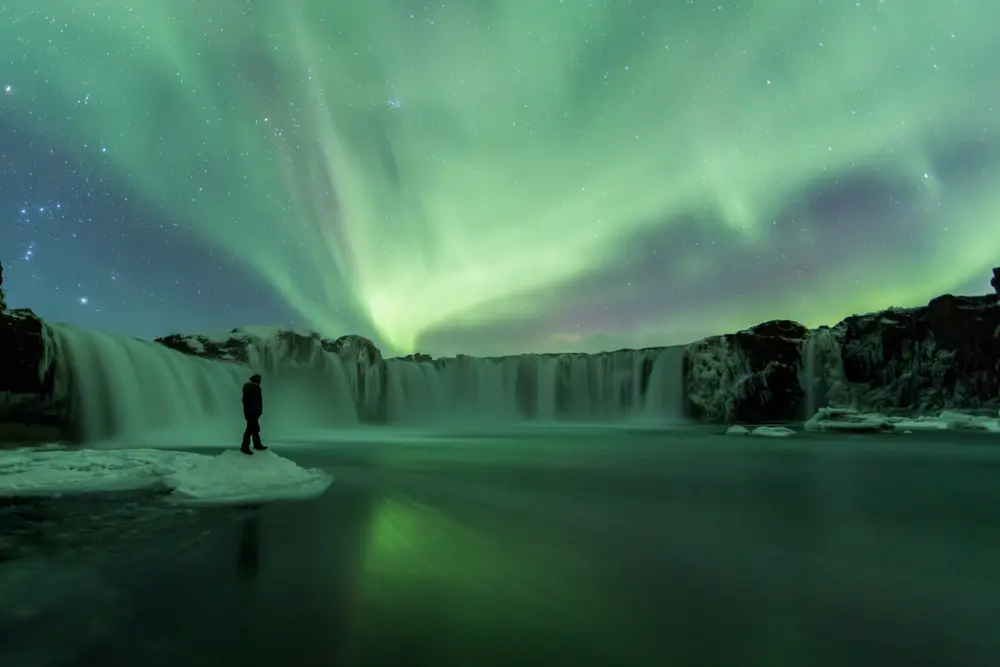Interest in the aurora borealis (or northern lights) has risen by 234%, with opportunities to see this bucket list natural light show becoming more common, due to heightened solar activity.
Otherwise known as ‘Solar Maximum’, this refers to the sun reaching the peak of its 11-year cycle, resulting in increased solar activity and in turn, a more regular appearance of the auroras across our night skies.
With this solar activity set to start peaking in September 2024 and lead well into 2025, James LaBelle, Professor of Physics and Astronomy at Dartmouth College, has put together his expert tips for anyone hoping to see the northern lights, including the one thing you really shouldn’t do.

When exactly can you see the northern lights?
While solar activity is currently peaking and the northern lights were visible in many parts of the northern hemisphere in August, Professor LaBelle describes that “it’s hard to predict exactly when the current cycle will peak; it looks likely to be early 2025 but could be as late as the first quarter of 2026. The chances of seeing aurora at low latitudes will tail off after that”.
So, while there is still ample time to catch the very best light shows of this solar cycle, the window of opportunity is minimised, when taking into account the need for a dark sky. “A major factor is having darkness, which means no or very little moon in the sky. The best opportunity to observe aurora is during approximately half the time when the moon is either below the horizon or very small,” explains Professor LaBelle.
What time of night will you see this natural light show?
“You can have activity at any time of day. There is actually aurora going on even in the daytime, but we can’t see it,” says Professor LaBelle.
While it might come as no surprise that seeing the lights is limited to the nighttime, there is actually a certain time of the night where your chances increase, “around midnight is typically when the aurora makes its most southerly extent, and when it is most active”.
What about light pollution? Can you see the northern lights from anywhere?
Unfortunately, built up cities and towns have made it increasingly difficult to see the auroras and, as Professor LaBelle explains, finding somewhere with minimal light pollution is paramount. “Access to dark sky is really important for viewing aurora. Even the presence of more than a sliver of moon can make it hard to appreciate anything but the brightest aurora”.
What’s the one thing you shouldn’t do if you want to experience the northern lights?
Outside of heading to bed early, an aurora-watching faux pas ties in with the very real need to keep light pollution to an absolute minimum, with Professor LaBelle pointing out a common habit of modern life: taking your phone out of your pocket to check the time or send a text.
“You want to keep your eyes adjusted to the dark, so looking at a phone or turning on a bright light would force you to readjust, losing some precious time watching!”
The cheapest places to stay overnight to see the northern lights
With many people living in areas of heavy light pollution and potentially missing out on a chance to see the auroras at their best, InsureandGo has also analysed average hotel costs close to or within locations across Europe, North America and Canada that are known for being a good base for aurora-watching, especially with peaking solar activity levels.
Ranked by the most affordable options, the list highlights alternatives to more expensive choices in the likes of Norway and Iceland that are often popular for those hoping to see the northern lights.
For example, beautiful locations in Scotland top the list, offering visitors stunning natural scenery and the kind of dark skies required for a once-in-a-lifetime natural light show.
| Rank | Location | Country | Avg. hotel cost (per night) |
| 1 | Isle of Harris | Scotland | £41.00 |
| 2 | Cairngorms National Park | Scotland | £54.00 |
| 3 | Gjogv | Faroe Islands | £58.00 |
| 4 | Brecon Beacons National Park | Wales | £72.00 |
| 5 | Rovaniemi | Finland | £80.00 |
| 6 | Fort McMurray | Canada | £80.00 |
| 7 | Exmoor National Park | England | £85.00 |
| 8 | Whitehorse | Canada | £86.00 |
| 9 | Northumberland National Park | England | £93.00 |
| 10 | Levi | Finland | £94.00 |
Letitia Smith, Head of Communications at InsureandGo comments: “Seeing the northern lights has featured on travel bucket lists for decades and there’s currently a great opportunity to experience them at their best, that many people won’t want to miss out on”.
“With this in mind, we would urge travellers to book up their accommodation as soon as possible, as the added interest in seeing the auroras will result in stays getting booked up quickly”.
“The great thing is that this increased solar activity means there are more locations to see the auroras from, meaning more options for varying budgets. However, in the excitement of seeing this natural phenomenon, remembering to make sure you have travel insurance to cover your holiday is a must”.
“Trips into dark sky places are often remote, and as Professor LaBelle points out, in the middle of the night. Meaning that while planning a trip to see these natural light shows with your own eyes is hugely exciting, it’s always best to make sure you are covered for an unplanned incident while away”.
Remember that you’ll need travel insurance before you head off to chase the northern lights.

